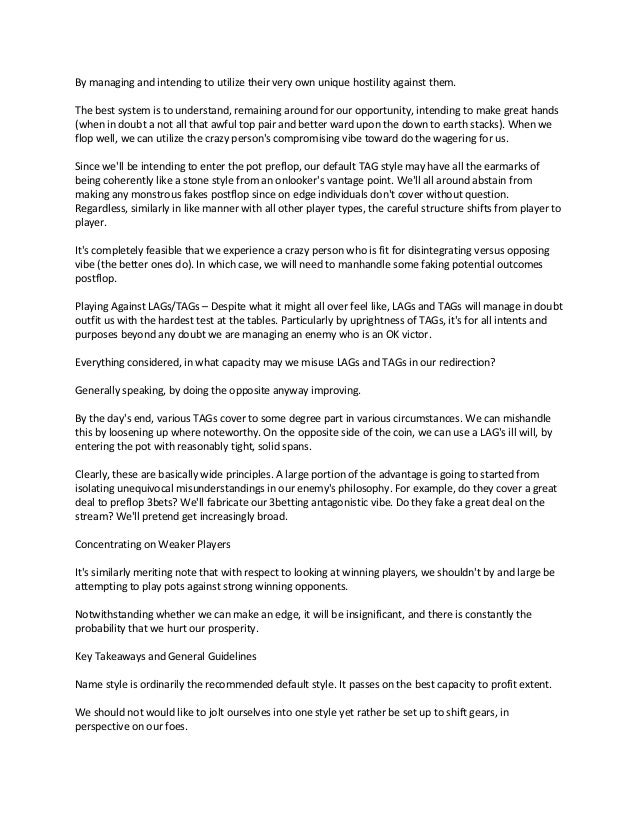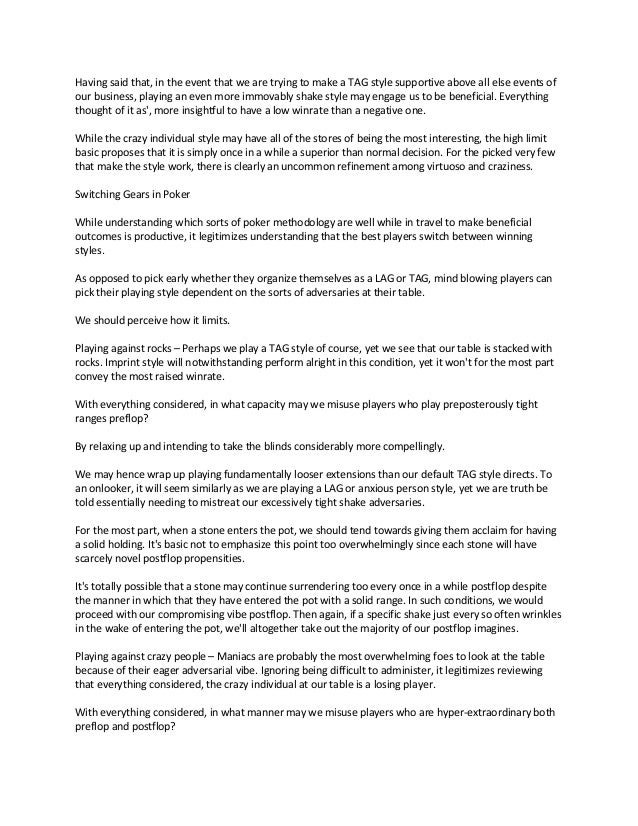Old-fashioned poker theory command a game based on tight and aggressive play. But this have changed after young online poker players have proved that more money could be won by playing another kind of style, the so-called loose-aggressive, or even hyper loose-aggressive.
The main benefit of the LAG-style is that you can win lots of pots without having legitime hands. That means simply that you could potentially win more hands, by a higher frequency.
For example, many players will call with straight or flush draws on the flop, but won’t call with those hands again on the turn if they miss. For example, say the flop is Q 7 3 and the LAG bets. Playing LAG doesn't mean raw aggression all the time, there are a few spots where you can open up your range pre and post flop, I'll give you a couple examples: Regular opens hijack, fish calls Cutoff or button, you should squeeze a lot of hands in the blinds Fish limps, regular raises late position, you should 3-bet very wide on the button/blinds. So what most poker players end up with is a style of play that is a percentage of each with a heavy slant towards one or the other; perhaps 75% TAG and 25% LAG. Furthermore, most players have a “fallback” style that they start a tournament with, or revert to in unfamiliar situations.
Although it's true that most winning players are TAGs, at the top of the pinnacle, the truly great online players are LAGs. Mark Vos
Matched pre flop and post flop aggression

When some players try to change their TAG-style to a LAG-style, they do it half-hearted, which result in a flawed game. If you, for example, play loose before the flop, you must be prepared to do so also after the flop. By raising pre flop, get called by an opponent and when don’t bet again, you are doing your opponent a twofold favor: you increase the pot, and you give it to him (if he got enough sense to bet).
That may be an exaggeration, but in principle it is true. You could of course refrain from betting and when instead call your opponent’s bet. That is something you more or less must do if you don’t bet yourself, but when you are passive, and if you are going to be passive post flop you better refrain from raise pre flop in the first place.
This don’t mean that you must continue to bet after the flop when you raise pre-flop 100 times out of 100. That would actually be non-optimal since it makes you vulnerable for check-raise bluffs from an opponent that observes the patterns. But, your standard play post flop must be an aggressive one if you are raising pre-flop. If you increase the pot, you must fight for it.
The texture on the flop will dictate when you should avoid a continue-bet. If three low cards are dealt on the flop, your opponent will probably don’t think you hit something and betting would therefore often be called. On the other hand, if you have hit something, just go ahead and bet, you will get pleasant implied odds!
How often you should bet also depend on the opponent’s style. If he is a calling station, you should bet into less pots when you miss the board. The same can be said if you meet a very aggressive player who often raise your bets.
But the standard play is to continue-bet. This will win many pots since your opponent for the most times doesn’t have anything. Many players will often call to see the flop, but are not very interested to fight for the pot without a hand. That's is one of the reasons why the LAG approach is so profitable.
Hyper loose-aggressive
Just being loose-aggressive wasn’t enough for everybody and when the hyper loose-aggressive was style born. There have obviously always been players that could be characterized as maniacs on the poker tables. That is just an observation of diversion among humans. But that is a complete other thing is: winning hyper loose-aggressive strategy.
From the perspective of old-fashioned poker theory, it was not plausible to play hyper-loose, or even less hyper-aggressive, and win. But in the days of online poker, things have changed. Many proofs have been found, both on low and high stakes levels, that the hyper LAG-style could be extremely effective.
Why does it work? Mainly because you have only two cards in games such as Texas Hold'em and in most cases your starting hand will not be very good; neither after the flop will your hand often be very good. Therefore, betting without a legitime hand makes sense.
Another reason is that 6-max tables is much more common than 9-tables in the online poker era. Full ring tables with 8-10 players were standard at brick and mortar casinos. It is more lucrative to fill the floor area with such tables since less dealers are needed per player. But online poker sites has unlimited floor space.
Playing at a table with eight other players is not the same thing as playing with five others. When you facing eight players, the risk is much higher that another player has a good hand. Trying to “steal” the pot with mediocre hands will because of that seldom work. Therefore, don’t try a hyper loose aggressive approach on these tables. You should do it on 6-max tables or in tournament formats that involves only two, three or four players.
The hyper loose-aggressive style doesn’t fit everybody. You must have it in you to bully your opponents and attack lots of pots. And you must be prepared to lose in the short-term. All forms of LAG-style play will increase the variance: you will experience both more real good session and more real bad ones. Not everyone can handle that mentally.
The other thing is that successful LAG-style play demands a lot from you. When TAG-style is more about the cards (to generalize some), LAG-style is much about playing the player. Yes, you will profit on the condition that most players don’t have a good cards in most cases, but you must also observe the players to find out which are obstinately going to fight for many pots and which will give them away with less resistance.
Related articles:
In Texas hold’em, a loose-aggressive player (LAG) plays most of his hands pre-flop, and often raises. Some such players are also called “maniacs.” They play their hands extremely aggressively, raising and re-raising perhaps as much as one out of three hands dealt – or even more often.
How To Play Poker Online
Let’s take a typical example: You are playing $4-$8 limit hold’em at your favorite local casino. Up to this point in time, you have been holding your own, and are a bit ahead. A new player joins your table. You have never before played against him; you don’t know his playing traits. So you watch him closely.
He starts out seeing the flop six hands in a row, and he raised pre-flop on four of those. In your mind, you have labelled him a LAG, and a “maniac” to boot. Two of those raised hands he won without any challenge, as his opponents mucked their hole cards. As for the other two that went to a showdown, on one occasion he had been dealt pocket Queens; the other hand, he tossed into the muck when his opponent (acting out of turn) turned up a decent hand. “Maniac” probably was bluffing on most of those hands.
How To Play Lag Poker Card Game
Unfortunately, he is seated two seats to your left. Thus, most of the time, you have to act before he declares. That puts you in a difficult position. Most of your playable hands aren’t strong enough to warrant an investment of a double bet to see the flop when he raises after you limp. (By the way, one way to spot a Poker Pigeon – i.e., a very unskilled player – is when a player asks for a vacant seat just to the right of a “maniac.” Call that the “dead man’s seat.”)
Of course, you would like to change your seat so that you are to his immediate left, or as close to that as possible. When such a seat becomes available, waste no time in announcing your seat change to the dealer. (Don’t let another sharp player beat you to the punch.)

Thereafter, you’ll know how he bets before investing any of your precious chips. When he raises, you can easily fold mediocre hands; they are not worth a two-bet. And, if you have been dealt a strong hand, you can re-raise (a 3-bet) to thin the playing field, as all your other opponents fold their hands. Ideally, in that case, it would be great to play heads-up against the “maniac” while you feel almost certain that you hold the best hand – and, hence, you are a big favorite to take the pot. In that case, you would be exploiting the “maniac’s” playing traits.
Two “Maniacs” in the Game
But what if a second “maniac” joins your game? That does happen on occasion, presenting an even bigger problem. If you are seated between them, you are in the worst possible position.
On the other hand, if they happened to be seated next to one another, then the previous strategy could work for you: When available, move your seat to their immediate left.
Otherwise, it’s time to take a long break (have lunch or go for a walk in the fresh air to invigorate yourself and reflect on the situation); or, better yet, request a table change.


Other Posts You'll Enjoy
- 4 Practical Tips for Playing the Tournament Poker Bubble
For many poker players, knowing how to properly play near the bubble of a tournament is something difficult to master. We're happy to share with…
- 4 Good Tips for Winning at Poker
Just starting out at poker? You probably want to win - like you see all those players doing on TV. It's a long road to…
- 4 Awesome Poker Moves to Make When Playing Flop Games
Here's an excellent strategy poker blog post brought to us by David Shatsky, a longtime member of the Cardplayer Lifestyle family. He writes about 4…
- Webcam Poker - Online Poker Revolution?
This guest post on Cardplayer Lifestyle presents an overview on one of online poker's newest developments: webcam poker. Read more to learn the advantages and…
- 4 Tips for Staying Safe When Playing Online Poker
Pretty much the worst nightmare for any online poker player would be their account being compromised. While online poker security is to a large extent…